Everything You Need to Know Before Visiting Zion National Park
From free shuttles to the best tips for hiking The Narrows.
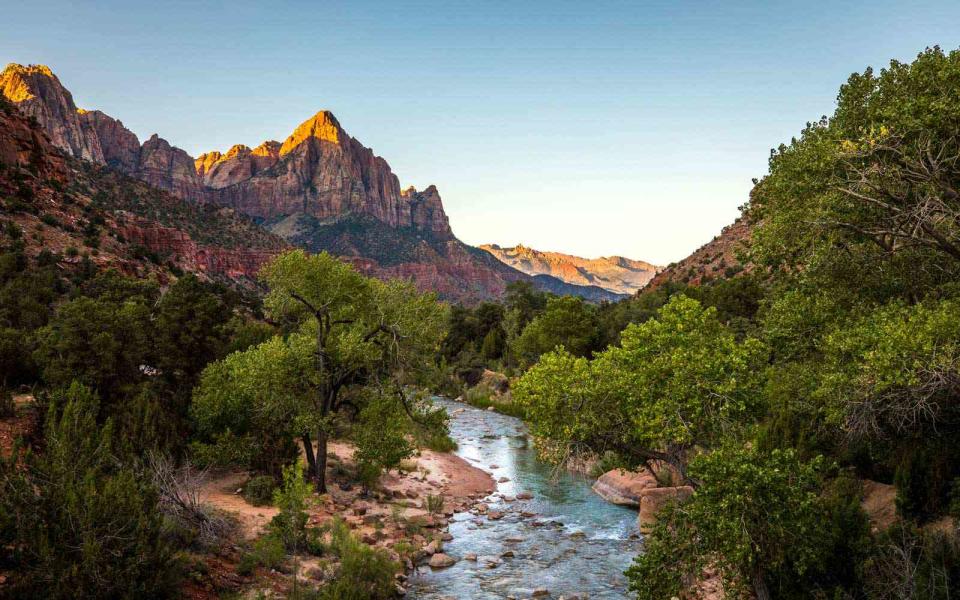
Zion National Park, one of Utah's "Mighty Five" national parks, is one of the most-visited parks in the U.S. With its gorgeous views, world-class hiking, and one-of-a-kind narrow slot canyons, it's really no surprise that people love visiting Zion year after year. Here's how you can plan an epic vacation to one of America's most treasured national parks, too.
Getting to and Around Zion National Park
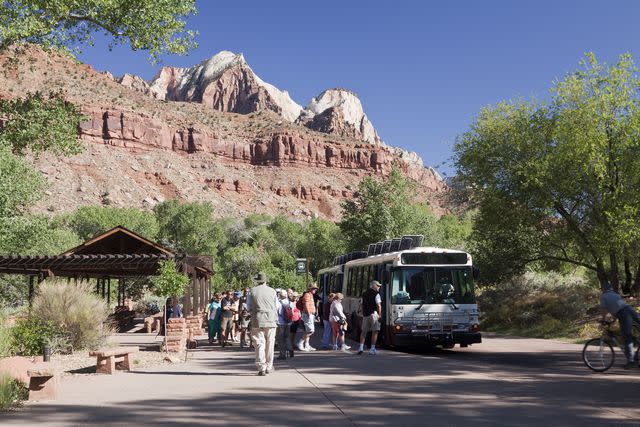
To get to Zion National Park, visitors can fly into the Las Vegas, Nevada airport, which is located 170 miles from the park, or into Salt Lake City, Utah, some 300 miles away. Or, if you can find a connecting flight, you could always fly into Saint George regional airport, which is 49 miles away and has flights from Salt Lake City and Denver, Colorado.
There are two free shuttles available in the park for most of the year, one that travels along the Zion Canyon Line between the Zion Canyon Visitor Center and the Temple of Sinawava and the other that connects Zion Canyon Village to the Majestic View Lodge. Many hikers use the shuttle system to take advantage of one way routes. Strollers and bikes (excluding e-bikes and fat tire bikes) are permitted.
Zion National Park Camping and Hotels
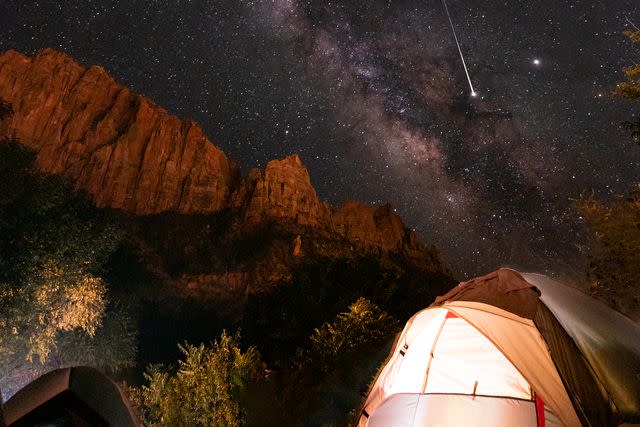
There are two options for travelers looking to stay at Zion: Camping and hotels. At the park, Zion has three campgrounds available. Watchman Campground is open year-round and requires reservations; Lava Point Campground, which closes during the winter season, recommends them. South Campground is currently closed for a long-term rehabilitation project. Reservations for the available campgrounds can be made on Recreation.gov or by calling 877-444-6777.
If you're into camping vibes but want to be pampered, Under Canvas Zion has luxury glamping tents with king beds and full bathrooms on 196 acres bordering the park. Guests also get access to activities within the park, including canyoneering and stargazing tours, mountain biking, rock climbing, and more.
If camping and glamping aren't for you, you can always book a stay at the Zion Lodge, the only in-park lodge at Zion. There, visitors can book not only a plush room to sleep in after a long day of hiking, but they can also enjoy a meal at the lodge's restaurant or book a horseback riding excursion through the park.
If the lodge is booked you could try Spirit, a brand new luxury resort in the area that will be fully open in 2023. Large suites that range in size from one- to five-bedrooms boast panoramic views of the landscape. Alternatively, there's also SpringHill Suites, a Marriott hotel that sits just outside Zion National Park. There, guests will also enjoy luxury rooms, on-site dining options, and even an outdoor swimming pool that provides unparalleled views.
Zion National Park Hikes
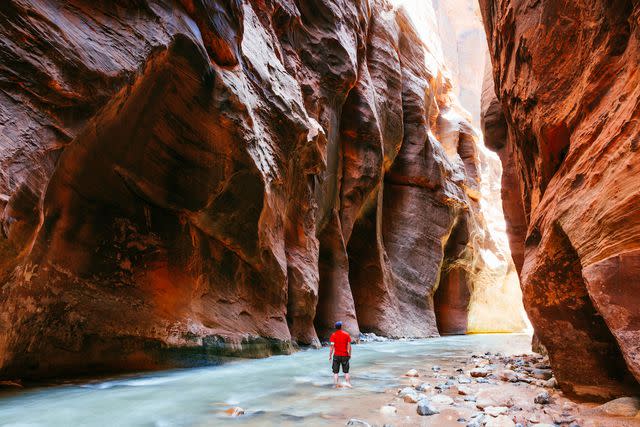
Matteo Colombo/Getty
There are miles and miles of hiking trails around Zion National Park. Difficulty varies, but Zion National Park also has a paved trail that can be used by hikers with wheelchairs. Unfortunately, some of the most famous hikes are not suited to all skill levels and may close if the conditions are not safe.
Pa'rus Trail
The most accessible trail in the park, this 3.5-mile round-trip route follows a paved route along the Virgin River from the South Campground to Canyon Junction. Bikes and leashed pets are allowed on this trail and it can be accessed from the Visitor Center.
Angels Landing
Zion National Park's most popular trail require visitors to apply for a permit before taking on this 5.4-mile round-trip challenge. The views are spectacular, but the route can be challenging and the long drop offs make it unsuitable for children or anyone with a fear of heights. It can be hiked in the winter if you have experience hiking in snowy conditions, but traction devices are strongly recommended.
The Narrows
An emblem of Zion National Park, this slot canyon trail goes upstream through a gorge, surrounding hikers with thousand-foot high walls on either side. You'll walk upstream along the Virgin River — close-toed shoes and poles are strongly recommended — which means balancing as you walk on round slippery rocks. The route is best done in the summer and early fall, but check in at the Visitor's Center for a detailed weather report as flash flood risks may close the trail force park authorities to close the trail.
Other Activities in Zion National Park
Besides hiking, the park's unique geology offers other opportunities for adventure like canyoneering, which you will need a permit for, and rock climbing, which is best done between March and May or between September and early November, when the weather conditions are ideal. Bicycles are only allowed on the paved Pa'rus Trail and certain roadways, like the Zion Canyon Scenic Drive. If you're in a car, you can also take a ride down the picturesque Kolob Canyons Road. Or for a more unique way to see the park, horseback riding tours are available from Canyon Rides along the Sandbench Trail. With so much whitewater to play with thanks to the Virgin River, experienced kayakers may be tempted to pack their paddles, an activity that can only be done if you secure a permit in advance.
Zion National Park Weather
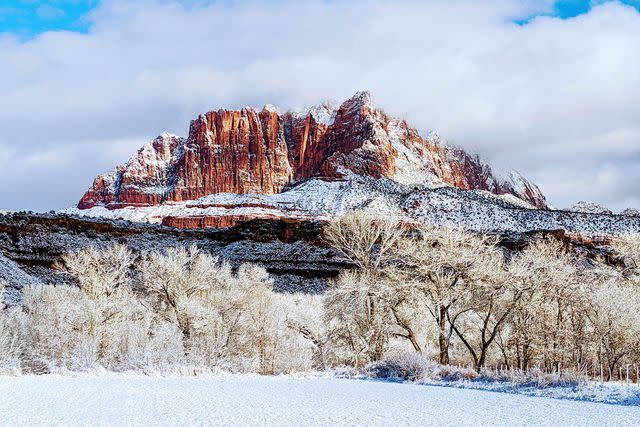
Robert_Ford/Getty Images
The weather in Zion National Park can vary greatly throughout the year. In the summer, the National Parks Service explains, temperatures can often exceed 100 degrees. In the winter, highs typically hover in the 50 to 60 degree Fahrenheit range, and the park can even see snow. So you may want to plan your trip in the spring or fall, when temperatures are more moderate and rarely surpass 90 degrees Fahrenheit.
The best time to visit Zion National Park, though, depends on your priorities. Given that it has quickly become one of the most popular national parks, you may want to avoid visiting between April and September if you hate crowds — the park receives 70% of its visitors in that range, with July being the busiest month. January tends to be the quietest month, and even if it is colder, you may get lucky with a warm day in the mid-50s. At the same time, this strategy may not be wise if you have your heart set on hiking the Narrows, which is best to do between summer and early fall. In spring the trail tends to close due to the rising water levels caused by snowmelt.
For more Travel & Leisure news, make sure to sign up for our newsletter!
Read the original article on Travel & Leisure.

